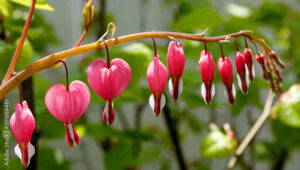Plant Information

Bleeding Heart (Dicentra sp.) is a genus in the Papaveraceae family with over 20 species native to North America and eastern Asia. The name Dicentra comes from the Greek words dis and kéntron meaning “twice” and “spur”, referring to the two spurred outer petals that give the flowers their distinctive shape. This distinctive heart shape, along with the stamen that protrudes from the bottom, is also what gives this flower its common name.
The heart shaped flowers, the vivid colors from white to pink depending on species and cultivar, and the low maintenance make bleeding hearts popular to grow in gardens. Their deeply divided lacey leaves give them an attractive fern-like look, especially when growing in shaded areas. They can be planted in partial to full shade, but can also tolerate full sun in cool climates, and they thrive in rich well-draining moist soils.
Bleeding hearts flower from late spring to early summer, after which the flowers are followed by elongated seed pods. They should be observed at a distance because all parts of the plant are poisonous to humans, and repeated contact with the plant can cause skin irritation.
Dicentra spectabilis, known simply as Bleeding Heart, is a species native to eastern Asia that can grow up to 3 feet tall and 4 feet wide. It will often self-seed but not often enough to be considered invasive.
Dicentra formosa, also known as Pacific Bleeding Heart, is native to western North America. It is similar to D. spectabilis in color, but only grows up to 1.5 feet.
Dicentra canadensis, also known as Squirrel Corn, is a much smaller species that is native to eastern North America. It typically only grows up to 10 inches tall and produces white flowers.
Economics
According to the USDA NASS Census of Horticulture, bleeding hearts sold for a value of $3.2 million in 2014 and $2.6 million in 2019.
Main Diseases Problems
Bleeding hearts are vulnerable to a couple of fungal diseases: crown rot and Fusarium wilt.
Main Pest Problems
Bleeding hearts do not have any significant problems with pests.
IR-4 Research
IR-4 has conducted 7 crop safety trials to determine if certain pesticide products cause any harm or leave unsightly residues.
Authors
Laura Werner, IR-4 Environmental Horticulture Program Research Assistant
References
https://en.wikipedia.org/wiki/Dicentra
https://plants.ces.ncsu.edu/plants/dicentra/
https://hort.extension.wisc.edu/articles/bleeding-heart-dicentra-spectabilis/
https://www.fs.usda.gov/wildflowers/plant-of-the-week/dicentra_formosa.shtml
https://www.wildflower.org/plants/result.php?id_plant=DICA/
https://portal.ct.gov/CAES/Plant-Pest-Handbook/pphB/Bleeding-Heart-Dicentra/
https://quickstats.nass.usda.gov/
